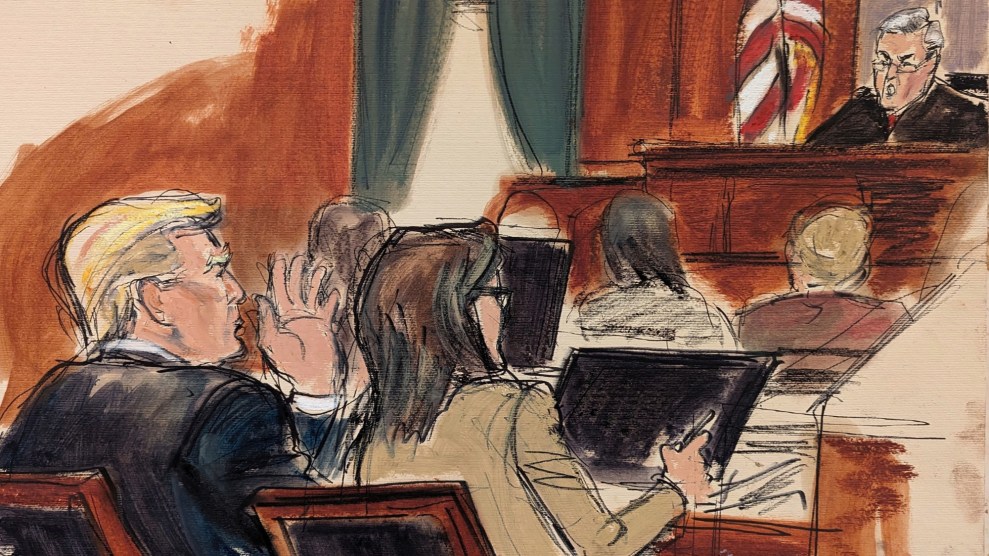
Elizabeth Williams/AP
District Judge Lewis Kaplan has said it multiple times: Donald Trump raped E. Jean Carroll in 1996. Kaplan wrote it in May 2023, when he presided over one of the trials against Trump. And he reminded jurors of the rape this week, during the latest proceedings in the multi-layered, winding rape and defamation cases brought against Trump by Carroll.
Last spring, author and journalist Carroll sued Trump, testifying that he had raped her decades ago and had defamed her since by denying the accusations. Carroll won that suit. The jury found Trump liable for sexual assault and said he must pay $5 million—but they came short of saying he had raped her due to the legal scope of New York State’s penal code.
In New York, someone can only be convicted of rape if they can prove vaginal penetration by a penis. In Carroll’s testimony, which mirrored what she had described privately for decades and publicly for the first time in 2019, she said Trump used both his fingers and his penis in the assault. But during the trial, the jury had only concluded that Trump had “deliberately and forcibly penetrated Ms. Carroll’s vagina with his fingers, causing immediate pain and long lasting emotional and psychological harm,” Kaplan’s decision from last year reads.
That the jurors did not find that Carroll had proven rape, Kaplan explained, “does not mean that she failed to prove that Mr. Trump ‘raped’ her as many people commonly understand the word ‘rape.’” “Indeed,” he continued, “as the evidence at trial recounted below makes clear, the jury found that Mr. Trump in fact did exactly that.”
Federally, rape is defined as “penetration, no matter how slight, of the vagina or anus with any body part or object, or oral penetration by a sex organ of another person, without the consent of the victim.” This broader explanation, while still dependent on penetration, would include assaults using fingers.
Even though Carroll’s case has taken place in the national spotlight, it exists within the confines of civil law. The reason Donald Trump was not found to have raped E. Jean Carroll has less to do with the events detailed in her story, and more to do with the fine print of the state’s legal code. The minutiae of New York’s law allows the former president, his supporters, and sexual violence cynics alike to tout the case as proof that Trump is not a rapist (notwithstanding the tens of other accusations of sexual misconduct against him). Following Carroll’s initial testimony, Republican senators did just that. “The whole case is a joke,” Sen. Marco Rubio (R-Fla.) said. “It makes me want to vote for him twice,” Sen. Tommy Tuberville (R-Ala.) told HuffPost.
Had this case happened outside of New York, however, the verdict could have been different.
Across the country, states’ criminal and civil legal systems vary quite a bit in how they define rape and other charges of sexual violence. Some, like Idaho, explicitly require penile penetration to be present for a rape charge, while others like Maine and Maryland have a more expansive definition of sexual violence that encompasses non-penetrative acts. Several states don’t have any “rape” charge at all, but opt for language like “criminal sexual assault” or “sexual battery.” Similarly, the phrase “sexual intercourse” takes on different meanings depending on the legal text.
In short, the same person could commit precisely the same crime and be charged with entirely different things based on the court room’s address. This dissonance deepens the complexities of trying to obtain justice for survivors. And, as Mother Jones has previously reported, more women who come forward with their experiences of assault are being met with libel claims—instances that, as Carroll’s case has shown, depend greatly on what language is used by the state to describe sexual violence.
In the court room on Tuesday, Carroll explained the fear she’s endured over the past years, citing that she now sleeps with a gun next to her bed. “I was attacked. I was attacked on Twitter. I was attacked on Facebook, I was attacked on news blogs,” she said. “I was brutally attacked.” These threats include, amongst other things, that she ought to be raped.
















